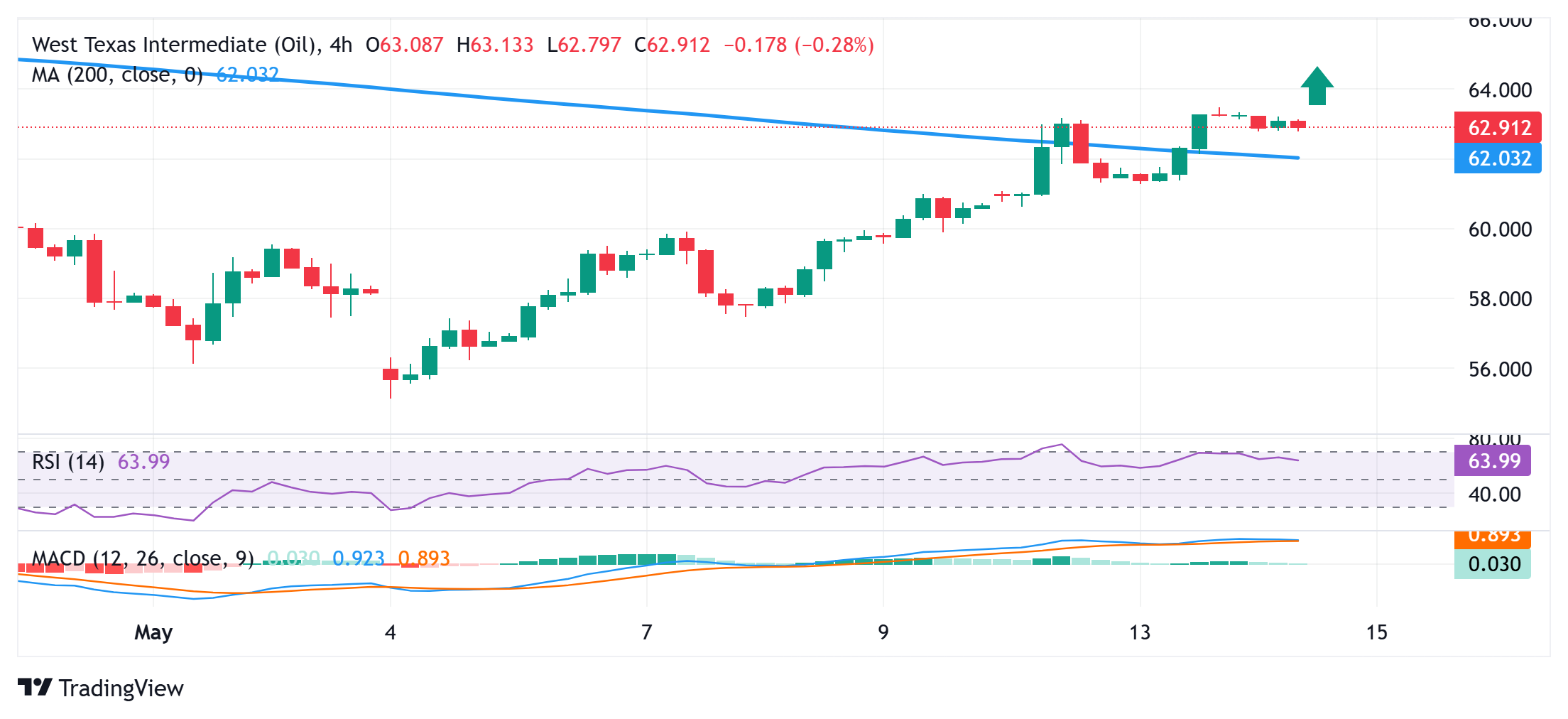- WTI drifts lower on Wednesday and snaps a four-day winning streak to over a two-week high.
- The technical setup favors bulls and supports prospects for the emergence of some dip-buyers.
- A convincing break below the $61.00 round figure is needed to negate the constructive outlook.
West Texas Intermediate (WTI) US Crude Oil prices remain depressed through the early European session on Wednesday and for now, seem to have snapped a four-day winning streak to mid-$63.00s, or over a two-week high touched the previous day. The commodity currently trades around the $62.85 region, down nearly 0.60% for the day, though the intraday downtick lacks bearish conviction.
From a technical perspective, the overnight breakout and close above the 200-period Simple Moving Average (SMA) on the 4-hour chart was seen as a key trigger for bullish traders. Moreover, oscillators on the daily chart have just started gaining positive traction and support prospects for the emergence of some dip-buyers near the said breakpoint, around the $62.00 mark, warranting some caution for bearish traders.
Some follow-through selling, however, could pave the way for deeper losses towards the $61.30 intermediate support en route to the $61.00 round figure. The next relevant support is pegged near the $60.40 region, below which Crude Oil prices could test the $60.00 psychological mark. The latter should act as a pivotal point, which, if broken, will suggest that an over one-week-old uptrend has run out of steam.
On the flip side, bulls might now wait for a move beyond the $63.45-$63.50 region, or over a two-week high set on Tuesday. Oil prices might then accelerate the positive move towards reclaiming the $64.00 mark and then test the $64.65-$64.70 horizontal barrier. This is followed by the $65.00 psychological mark, which, if cleared decisively, should pave the way for a further near-term appreciating move.
WTI 4-hour chart

WTI Oil FAQs
WTI Oil is a type of Crude Oil sold on international markets. The WTI stands for West Texas Intermediate, one of three major types including Brent and Dubai Crude. WTI is also referred to as “light” and “sweet” because of its relatively low gravity and sulfur content respectively. It is considered a high quality Oil that is easily refined. It is sourced in the United States and distributed via the Cushing hub, which is considered “The Pipeline Crossroads of the World”. It is a benchmark for the Oil market and WTI price is frequently quoted in the media.
Like all assets, supply and demand are the key drivers of WTI Oil price. As such, global growth can be a driver of increased demand and vice versa for weak global growth. Political instability, wars, and sanctions can disrupt supply and impact prices. The decisions of OPEC, a group of major Oil-producing countries, is another key driver of price. The value of the US Dollar influences the price of WTI Crude Oil, since Oil is predominantly traded in US Dollars, thus a weaker US Dollar can make Oil more affordable and vice versa.
The weekly Oil inventory reports published by the American Petroleum Institute (API) and the Energy Information Agency (EIA) impact the price of WTI Oil. Changes in inventories reflect fluctuating supply and demand. If the data shows a drop in inventories it can indicate increased demand, pushing up Oil price. Higher inventories can reflect increased supply, pushing down prices. API’s report is published every Tuesday and EIA’s the day after. Their results are usually similar, falling within 1% of each other 75% of the time. The EIA data is considered more reliable, since it is a government agency.
OPEC (Organization of the Petroleum Exporting Countries) is a group of 12 Oil-producing nations who collectively decide production quotas for member countries at twice-yearly meetings. Their decisions often impact WTI Oil prices. When OPEC decides to lower quotas, it can tighten supply, pushing up Oil prices. When OPEC increases production, it has the opposite effect. OPEC+ refers to an expanded group that includes ten extra non-OPEC members, the most notable of which is Russia.

